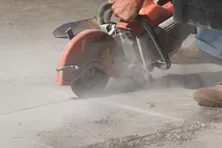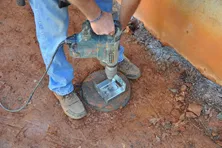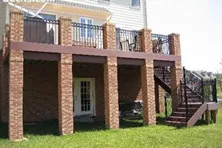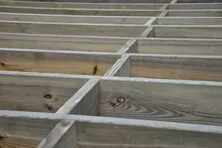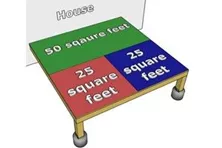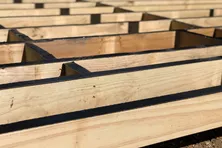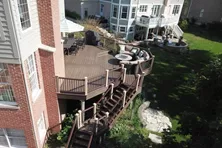The Buried Post Footing
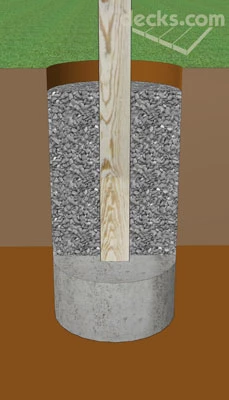
This footing method involves pouring a concrete pad at least 12” thick at the base of your hole. Next, set a pressure treated wood support post rated for "ground contact" on top of the pad and backfill the soil into the hole. "Ground rated" treated wood contains a higher concentration of preservative chemicals than normal wood and will offer increased protection from decay while buried in soil. This is the same type of wood that is used for retaining walls. The pressure treatment companies insist that these posts will last longer in the ground than the deck frame that is built above it, and this practice is accepted by the IRC code.
The buried post method offers the advantage of reducing the amount of concrete work required for each footing and actually provides additional lateral (side-to-side) support to the post to resist wind loads. It also reduces the amount of soil you need to haul away and can save you some money because you no longer need concrete anchors and post base hardware. The only obvious disadvantage is that if the post is ever damaged, it will be very difficult to replace.
Cutting a Concrete Pad
Learn how to use a concrete saw to cut a hole in a patio slab to install a deck footing.
Prevent Deck Sinking
Sinking deck footings can lead to serious problems. Learn what can cause concrete footings to sink. Properly installed footings will resist sinking.
Digging Foundations
Learn how to hand dig or mechanically dig your deck footings with step-by-step instructions. Learn what to do if you hit a rock.
How to Decorate Deck Support Columns
Browse some examples of decorative deck support posts for tall decks.
Deck Floor Joists
Step-by-step instructions and tips on how to frame. Learn how to install treated wood joists and beams to build a strong deck.
Reinforcing Deck Rim or Band Joists
Learn a technique to strengthen your guard rails by installing a double rim joist and adding structural blocking to reduce bounce.
More Helpful Resources
Explore Articles by Topic

Footings
Information related to installing frost footings for decks

Framing
Learn structural framing methods

Decking
Learn about wood and composite decking materials

Stairs
An in-depth look at the complex issue of how to build stairs

Railings
How to install guardrails and handrails to meet IRC code

Features
An overview on water drainage, benches, planters and lights

Design
The basics of deck design

Planning
Learn about permits and working with contractors

Porches & Patios
Build a covered deck to enjoy all seasons

Ledger
Proper attachment techniques

Care
Maintain your deck to maintain your investment

Materials
An overview on water drainage, benches, planters and lights
How many footings do I need?
Learn how to determine the number of footings and support posts you need for your deck when designing your deck frame.
Footing Size
Learn how large to make your deck footings. Use our table for maximum allowable loads to determine the proper size for your soil type.
Do I need to use rebar?
Our inspector discusses using steel rebar for deck footings.
Why is Joist Protection so Important for Your Deck?
If you’ve ever seen a piece of wood left out in the weather for any period of time, you know what happens: decay. Whether through wet rot, insect damage, or mildew, the fibers begin to break down.
Deck Joist Cantilever & Overhang Rules
Learn what factors determine the maximum joist cantilever overhang that is allowed.
Framing a Deck Parallel to a House
Learn about an alternative framing method that allows you to install your decking perpendicular to the house and makes the deck free standing.
Explore Articles by Topic

Footings
Information related to installing frost footings for decks

Framing
Learn structural framing methods

Decking
Learn about wood and composite decking materials

Stairs
An in-depth look at the complex issue of how to build stairs

Railings
How to install guardrails and handrails to meet IRC code

Features
An overview on water drainage, benches, planters and lights

Design
The basics of deck design

Planning
Learn about permits and working with contractors

Porches & Patios
Build a covered deck to enjoy all seasons

Ledger
Proper attachment techniques

Care
Maintain your deck to maintain your investment

Materials
An overview on water drainage, benches, planters and lights




